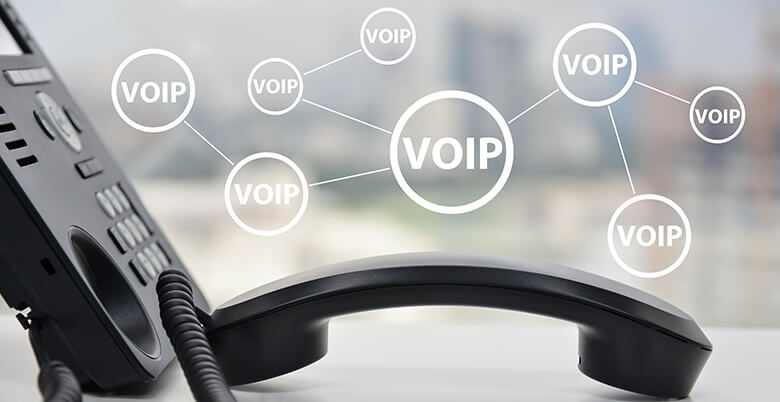Archive Post
Collaboration made easy with IP enabled Video Phones
A VoIP phone is a hardware- or software-based telephone designed to use voice over IP (VoIP) technology to send and receive phone calls over an IP network. The phone converts analog telephony audio into a digital format that can be transmitted over the internet and converts incoming digital phone signals from the internet to standard telephone audio.
VoIP phones, also known as IP phones, include features and capabilities not found in traditional analog phones. They also have additional performance requirements because phone calls are placed over the internet instead of the legacy public switched telephone network (PSTN).
How does a VoIP phone work?
Some VoIP phones require A/C adapters for power, while others use Power over Ethernet (PoE). PoE uses an Ethernet cable instead of an A/C adapter and removes the need for separate power and data cables.
Several networking components are required to make VoIP phones work. Phones are assigned IP addresses through the Dynamic Host Configuration Protocol (DHCP), which automatically configures the network and the VoIP parameters. A domain name system (DNS) tracks the IP addresses to enable devices, such as IP phones, to connect to each other.
VoIP phones require a number of protocols to facilitate the delivery of voice communications over the internet. H.323 is the most commonly used VoIP protocol that supports audio, video and data communications across IP networks. It provides several VoIP functions, including bandwidth management and call control.
Session initiation protocol (SIP) is a signaling protocol that sets up VoIP connections and is used as an alternative to H.323. Real-Time Transport Protocol (RTP) is used to send and receive multimedia information between two devices. VoIP services use RTP and SIP or H.323 to stream multimedia content. The Simple Traversal of UDP through NAT(STUN) protocol is used on some SIP-based VoIP phones to enable communications behind network firewalls, which can sometimes block SIP and RTP packets.
Some providers use their own proprietary protocols for VoIP phones. For example, the Skinny Client Control Protocol (SCCP) is a proprietary Cisco standard for communicating with H.323 VoIP systems.
Types of VoIP phones
The two main types of IP phones are hardware-based and software-based phones.
Physically, a hardware-based VoIP phone resembles a traditional hard-wired or cordless telephone. These phones include physical features such as a speakerphone or microphone, a touchpad, and display hardware to show user input and caller ID. VoIP phones also feature call transfer, multiparty calling and support for multiple VoIP accounts. Some VoIP phones can transmit and receive image data during calls, so they are considered video telephones.
Software-based IP phones, also known as softphones, are software clients installed on a user’s computer or mobile device. The softphone user interface often resembles a phone handset, with a touchpad and caller ID display. A headset with a microphone that connects to the computer or mobile device is encouraged, or sometimes required, to make calls. Users can also make calls using their device if it includes a built-in microphone
Softphone clients offer similar capabilities to hardware-based IP phones, such as voicemail, call conferencing and call transfer. Some clients may offer additional capabilities, such as video conferencing and instant messaging, however.
Traditional analog phones may also be converted into IP phones by connecting to an analog telephone adapter (ATA). Analog phones can be converted by plugging the Ethernet network jack into the ATA, which then connects to the phone. The analog phone will connect to the internet rather than the PSTN, and it will appear to the phone system as a VoIP phone.
Advantages and disadvantages of VoIP phones
- Organizations can reduce calling costs by switching to VoIP services. While traditional analog phones can have lower upfront costs, they are more costly to support, upgrade and integrate with communications applications. IP phones also offer cheaper long-distance and international calls, as VoIP phone calls are charged at the local rate of the call’s destination.
- VoIP phones offer greater mobility and scalability than traditional handsets. If an organization moves to a new location, it doesn’t need to acquire new phone lines, which it would with a traditional phone system. Adding new phones to a VoIP system is only limited by the available bandwidth on the organization’s network. Softphones also provide increased mobility, as the clients are not tied to physical locations like they would be with hard-wired phones.
- VoIP phones can also integrate with other communications applications. For example, organizations can integrate their customer relationship management (CRM) software with VoIP phones to enhance caller ID and keep records of call information.
- VoIP phones, however, do have disadvantages. For example, VoIP phones require a reliable internet connection and are susceptible to bandwidth constraints. With insufficient bandwidth, phone calls may experience latency, which can result in delays and dropped calls. Additionally, if an organization has a power or internet outage, users cannot make calls from their VoIP phones.
Source: www.techtarget.com
Telemedicine – A life Saver!
What is Telemedicine? Telemedicine uses video conferencing and other telecommunication tools to deliver healthcare at a distance. It promises patients greater convenience and time saved. For medical clinics and hospitals, it delivers time, money, and resource savings. In rural areas with fewer medical facilities, telemedicine promises better healthcare for residents.
Telemedicine provides access to healthcare information and records, enables access to specialists, improves communication between doctors and patients, and helps professionals gather and share important health data.
Technology supports telemedicine
A number of technologies make telemedicine a practical reality. Video conferencing plays a key role, together with secure, low-cost mobile communications that support real-time collaboration through tablets and smartphones.
Video conferencing is available on mobile devices with a high-speed Internet connection and softphone, a software application. Because video conferencing reach any location with Internet access, a mobile collaboration between doctors and colleagues or doctors and patients can occur inside hospitals, medical centers, and anywhere in the country, even remote rural areas.
Healthcare professionals transmit data such as electronic records and other documentation securely. In addition to real-time video collaboration, doctors use recorded video content to support patient education, aftercare, and wellness programs in the community
Improving collaboration within hospitals
In hospitals, doctors and nurses frequently move between wards, visiting patients. To seek advice or collaborate with specialists, they connect and share patient information via the hospital’s internal wireless networks using smartphones or tablets.
Increasing access to specialists
To see and assess a patient over live video within minutes of arrival at the hospital. The faster a patient receives stroke treatment, the better chances they will recover without permanent disability. Video collaboration is accelerating ‘door to needle’ treatment by minutes, sometimes even hours, time-saving that could change a person’s life forever.
Changing the pattern of patient visits
As an alternative to a home visit, doctors may video or Web conference with patients with less mobile or medically unable to visit a health center. Doctors discuss the patient’s condition and recommend medication or treatment.
Remote monitoring systems grant access to critical patient data, like those with heart conditions or diabetes. This reduces home visits for routine assessments and provides timely alerts of changes in patients’ conditions that may require urgent attention.
Reducing hospital readmissions
Many hospitals find that readmissions put further pressure on their already limited resources. Although patients receive aftercare instructions before being discharged, when problems occur, patients are readmitted for further treatment or support. There are five areas that frequently lead to hospital readmissions:
- Hospitals creation and implementation of effective discharge plans.
- Patient non-compliance with medication and care instructions.
- Compromised follow-up care due to poor collaboration.
- Family caregivers not connected or informed to assist with care.
- Patient condition deteriorates and necessary care not accessed.
Video collaboration and content management solutions help hospitals to deal with these challenges.
To improve patient discharge plans, hospitals can offer live, collaborative video at the time of discharge. A live conversation ensures patients, caregivers, and family members participate in the creation of a discharge plan and fully understand what action to take as the patient returns home.
Hospitals may also create a video recording explaining the discharge plan for the patient and family. The information explains what to expect in a normal recovery, compared to symptoms that represent a risk to the patient.
If patients forget the care instructions or have difficulty with their medication, the hospital sends reminders via real-time video collaboration or a pre-recorded video library. This makes reviewing patient care easy.
As part of the recovery process, patients and caregivers benefit from the support of their assigned healthcare providers. They can have virtual access to their primary care physician, case manager, or other professionals via live video. These video follow-ups help long-term patients benefit from feeling connected to their continued care.
Video collaboration assists the patients’ family who may live outside the area but want to participate in the care process. Family members can participate in video calls to create home care plans, learn to recognize risks, and assist with communication.
If a long-term patient’s condition changes or deteriorates, video collaboration enables access to their care team without resorting to readmission. Real-time video interaction helps case managers, nutritionists, physical therapists, primary care physicians, and others adapt treatment plans as changes occur in health and behavior.
Improving access to rural healthcare
In remote areas with limited medical resources, telemedicine provides local doctors a higher standard of care for their patients. Besides the opportunity for virtual home visits, telemedicine gives local professionals access to specialists anywhere in the country.
Local doctors gain insight into cases and procedures beyond their own experience or skills. It assists the diagnosis of complex cases, even allowing surgeons to conduct complex procedures with live video under the direction of a remote expert.
Supporting preventative care in the community
Telemedicine is playing an important role in preventative medicine. As part of the National Prevention Strategy, video conferencing enables hospitals, clinics, health departments, community health centers, community colleges, and facilities like rehab centers and skilled nursing facilities to collaborate and provide community-based services that contribute to the health and wellness of the public.
In smoking cessation programs or alcohol and drug abuse prevention, community teams utilize pre-recorded educational content or hold live interactive video sessions. They hear from experts in the field and discuss issues with doctors and nurses as well as peers in the community who struggle with similar problems.
Changing attitudes
Despite the promise and recent accomplishments of telemedicine, barriers to its wider adoption remain. A study by The Economist Intelligence Unit found 49 percent of respondents believe patients would be concerned about the risk of data breaches.
Although video collaboration is capable of providing benefits throughout the healthcare industry, professionals must be aware of privacy issues. Any organization providing doctors, nurses, and other workers with remote access to patient data must ensure the security of data transmitted by video or other communication channels.
Some insurers refuse to support telemedicine due to increased costs for fewer perceived health benefits. And, State medical boards impose differing telemedicine laws and restrictions on doctors. Procedures for telemedical treatment are not standardized across State lines.
Looking to the future, telemedicine has the potential to transform the way doctors deliver care, promising improved treatment, and saving more than time and money
source:voipreport.com
Digital Signage for effective retail marketing
Digital signage solutions are being exploited by most business owners today to give them an edge over their competitors. There are many different benefits digital signage will have on your business, which can help you become more successful within your industry. Digital Signage is made up of a variety of technologies used to replace traditional print and other media in the retail environment in a visually dynamic form..
The importance of creating customer experiences in the retail environment is well-documented and has been proven to influence consumer decision-making at the point of sale, as well as helping to enforce branding and enriching the overall shopping experience. Today, more and more retailers are beginning to recognise and reap the benefits of using digital displays and bespoke in-store music as part of their branding and customer shopping experience. It allows shoppers to visually interact with the brand’s products or promotions whilst still in the store environment, where actual purchasing decisions can be made.
Here are 4 ways in which digital signage can be used in-store for effective retail marketing:
- In-Store Digital Advertising
Advertiser driven digital signage networks allows advertisers to buy airtime in order to inform customers about their products and services and in turn drive more sales at the point of decision. The placement, size of commercial screen, type of content and other circumstances in store can vary quite a bit, but the most successful networks are always treated as any other in-store medium. That is to say, digital signage is like any other form of point-of-purchase advertising that can be bought by marketers and used to the reach customers on the sales floor.
- In-Store Digital Signage and Music
Retailers can utilise effective retail digital signage to promote their products, brands and services to their customers and also attract potential customers with strategically placed screens in storefront windows. In-store music has also added to the customers’ shopping experience and when these powerful channels are integrated, a retailer can efficiently deliver their marketing message visually and audibly to the customer right at point of purchase. The X2O Media Platform, now available in South Africa, enables users to communicate key messages in real time to target consumers via a range of digital devices– all from one solution.
- Employee Training and Skills Management
Digital Signage has been successfully used to display employee training videos, health & safety and other corporate messages before and after trading hours. Employee training can be further enhanced to include Training on Demand (TOD), which allows training videos to be played at times set by the individual store management and it allows for the videos to be paused, rewound, forwarded and stopped. TOD is a revolutionary bolt-on product that allows enables effective training of staff whilst having a huge cost savings for any distributed company.
- Touch Screen Kiosks
Self-service touch screen kiosks have been around for a long time, but as newer applications are being adopted by retailers, there has been a new resurgence of the technology. The new cutting-edge technology includes additional functionality, such as: self-service credit applications in-store, interactive product information and guided selling, wayfinding systems, product locators and price checking units, loyalty programmes and customer satisfaction.
The effect of the visually appealing display gives retailers the opportunity to improve their customers’ shopping experience, make each employee more productive, reduce the load on customer service staff and, if possible, offer a supplementary form of income
Why huddle rooms should be part of your collaboration strategy?
Huddle room video conferencing is more than setting up a webcam and speakerphone in a small room. Why huddle rooms should be part of your collaboration strategy?
For decades, collaboration technology has been limited to larger, integrated, and expensive meeting rooms. But next generation workers, and the need for companies to complete on a global basis, will drive demand for collaboration solutions throughout the organization. Workforce is embracing a new way of working where connectivity, rich media and access to content across devices and locations are a given. Modular and flexible solutions allow teams to transform their works paces. Over the next few years, advanced audio-visual and collaboration products and services will make their way into the millions of existing smaller meeting rooms (huddle rooms).
Video has only recently become a mainstream option for businesses. If your organization does not have a forward-looking video strategy, then you’re probably entrenched in legacy-based and hardware-based systems for dedicated use in a boardroom. Additionally, you’re probably thinking of video as a stand-alone application, rather than integrating it into a broader collaboration vision.
When considering today’s collaboration needs, video is far more pervasive and practical than conference room scenarios. While conference rooms are still important, huddle rooms have emerged as equally important for collaboration. Huddle rooms are typically smaller meeting spaces that suit different use cases and need to be part of your strategy, whether for video or your overall collaboration planning.
As workforce become more distributed, the need for collaboration becomes more important. Informal and ad hoc meetings are becoming more common, especially among small teams. Huddle rooms are ideal for this mode of working. To support that workflow with business-grade tools, you need to consider purpose-built video services. Video vendors are tuned into this shift in the market and now offer right-sized services for huddle room video conferencing.
There’s a big gap between costly telepresence systems for large groups and consumer-grade applications that anyone can grab from the web. Huddle rooms need to support serious collaboration — and that means having reliable connectivity, high-quality audio and video, full integration with other applications, a consistent user experience and, of course, ease of use. You can’t get that with a patchwork approach using somebody’s webcam and a noisy speakerphone, especially if two or more people are on the call.
Huddle rooms are ideal for those in-between video collaboration needs. If you’re adding huddle rooms as purpose-built collaboration spaces, you need to think strategically about the tools. Organizations have a wide range of video services to choose from based on cost and quality. You need to plan your video choices in tandem with planning for your huddle rooms. This strategic approach provides employees with a holistic service for small-scale collaboration. Once deployed, the benefits should be evident immediately.
Source:http://searchunifiedcommunications.techtarget.com/answer/How-do-huddle-rooms-fit-in-video-conferencing-strategies
Innovative features of IP telephony that could benefit your business
We have often heard about the VOIP phone system. To be more specific it is a technology that has been around for some time, as mass market VoIP services were first launched in 2004. It allows users to make and receive free voice calls over the Internet. More recently, providers have found increasingly innovative uses for VoIP technology that are helping businesses large and small to be more efficient, streamlining workflows and saving money simultaneously. Here are a few innovative uses for VoIP that your business might be interested in:
1. Interactive voice recognition
Ever called a company and been greeted by a pre-recorded voice asking you to select the reason for your calling? “Please press 1 for…” and so on. This is an interactive menu based on a VoIP system. What’s more, as voice recognition software has developed, interactive VoIP menus have integrated this software to provide a more intuitive means for users to choose options. In the near future, software will develop to the extent that a customer will be able to explain their query as if they were talking to a human, and the VoIP-based interactive voice recognition system will work out who is the most appropriate employee to take the customer’s call.
2. Office integration
Most usefully, VoIP allows an office manager to create a linked-up network of phones that can communicate with each other and send each other information. For instance, VoIP would allow a system that shows via an online portal when any particular employee is currently on the phone. This helps their colleagues know whether a particular employee is preoccupied. More broadly, VoIP facilitates the integration of the phone system into other physical areas of the office. Need to be able to answer the door buzzer and unlock the door from your desk? A VoIP system makes it possible to talk to your visitor and let them in, all through your desktop phone handset.
3. In-call employee coaching
The fact that a VoIP phone system is entirely integrated gives rise to some especially useful features. One feature, known as ‘barge,’ allows one employee to listen in on the phone call of another employee with or without their knowledge. This is invaluable for managers looking to monitor their team and give valuable feedback based on their call performance. An equally useful feature is ‘whisper,’ which gives one employee the ability to talk to another employee during a call without the user at the other end of the line being aware. Again, this could come in handy for managers hoping to coach their team members during calls as well as before and after.
4. Call routing and forwarding
The routing and forwarding capabilities of VoIP are almost endless. A customer who calls can be directed to an interactive menu (as mentioned above), a group of phones or even a certain employee’s phone in a different office in a different state. VoIP routing and forwarding systems today are incredibly advanced, offering any degree of complexity that you require. For employees on the go, one particularly useful feature is the ability to forward a call from their desktop phone to their mobile or even their laptop.
5. Conference calls
A traditional phone line will typically only allow calls to be made between two users using two phones. VoIP technology opens up many possibilities when it comes to conference calling. At the more innovative end of the spectrum, VoIP allows video conference calling between many different users. There are even a number of VoIP services that will host these conference calls for free.Above are only five of the many things that VoIP can do. Implement VoIP in your business to find out how you can benefit from it.
Source:http://it.toolbox.com/blogs/voip-news/5-innovative-voip-features-that-could-benefit-your-business-78392
How much value Collaboration solutions add to your workplace?
Collaboration has undergone a major change since it moved out of the boardroom. It’s more democratic, available and affordable for every employee. It’s accessible from any location on any desktop or mobile device. And, it’s becoming an integral part of the workplace of the future.
Collaboration is successful when employees throughout the organization are able to easily interact, participate in projects, share ideas, and provide feedback to colleagues. To support this, they need easy-to-use channels of communication and a quality experience when they collaborate. That helps build a collaborative environment by engaging people and showing how collaboration can transform working practices.
While solutions like VoIP and Unified Communications (UC) offer many important collaboration features and services, it’s important to focus on how those features help employees to do their work more efficiently.
Recent findings from Avaya, including the Team Engagement Solution Survey, offer some useful insights. The survey helps to identify how much value collaboration solutions add and where they need to change.
Email lives on
One question produced surprising results. When businesses were asked which collaboration solution was most important for enabling employees to get work done, email topped the list at 91 percent.
Office suites at 47 percent were ahead of web conferencing at 38 percent and instant messaging at 35 percent. Respondents also ranked email as the top solution for ease of use at 83 percent with instant messaging not too far behind at 67 percent.
Although email is frequently written off as a solution of the past, the survey indicates that it remains an important part of the collaboration process.
Integration is essential
There was a strong indication from businesses that integration of communication and collaboration tools is important. In fact, 90 percent agreed it was important.
When asked about the importance of integrating collaboration tools with business applications such as customer relationship management (CRM) or enterprise resource planning (ERP) systems, 78 percent of respondents were in favor.
However, opinion was divided over whether different types of collaboration tool work well together. For example, 51 percent of respondents felt that instant messaging and web conferencing were well integrated, while 49 percent felt they didn’t work together.
Collaboration solutions need more
The survey also asked businesses about their “wish lists” for collaboration. The most popular “must have” was a feature that supports screen sharing. That resonated with 95 percent of respondents.
Close behind with 92 percent was a solution that allows users to schedule meetings from their calendar apps. Integration with productivity tools like Microsoft Office or Google Docs was popular with 77 percent of respondents.
User experience improves ROI
The emphasis on driving team engagement through the right collaboration tools has a positive impact on ROI, according to Avaya. 52 percent of engaged employees say that work brings out their most creative ideas, helping to increase innovation and drive future growth.
The most-engaged workplaces experience 18 percent higher productivity and 12 percent higher profitability. Highly engaged employees are 87 percent less likely to leave, reducing recruitment costs and retaining skills and knowledge.
Source: http://thevoipreport.com
Security threats in VOIP!
With every new communication tool comes certain threats and VoIP is no different. While using VoIP has far more benefits that it does risks, it is important to be aware of the risks that do exist. Whether you are a long time VoIP user or thinking about moving to the system, having a good understanding of what to expect can protect your business. So what VoIP threats exist?
Identity and service theft
Service theft can be exemplified by phreaking, which is a type of hacking that steals service from a service provider, or use service while passing the cost to another person. Encryption is not very common in SIP, which controls authentication over VoIP calls, so user credentials are vulnerable to theft.
Eavesdropping
Most hackers steal credentials and other information. Through eavesdropping, a third party can obtain names, password and phone numbers, allowing them to gain control over voicemail, calling plan, call forwarding and billing information. This subsequently leads to service theft. Stealing credentials to make calls without paying is not the only reason behind identity theft. Many people do it to get important information like business data.
A phreaker can change calling plans and packages and add more credit or make calls using the victim’s account.
He can of course as well access confidential elements like voice mail, do personal things like change a call forwarding number.
Vishing
Vishing is another word for VoIP Phishing, which involves a party calling you faking a trustworthy organization (e.g. your bank) and requesting confidential and often critical information.
Viruses and malware
VoIP utilization involving soft phones and software are vulnerable to worms, viruses and malware, just like any Internet application. Since these softphone applications run on user systems like PCs and PDAs, they are exposed and vulnerable to malicious code attacks in voice applications.
DoS (Denial of Service)
A DoS attack is an attack on a network or device denying it of a service or connectivity. It can be done by consuming its bandwidth or overloading the network or the device’s internal resources.
In VoIP, DoS attacks can be carried out by flooding a target with unnecessary SIP call-signaling messages, thereby degrading the service. This causes calls to drop prematurely and halts call processing.
Why would someone launch a DoS attack? Once the target is denied of the service and ceases operating, the attacker can get remote control of the administrative facilities of the system.
SPIT (Spamming over Internet Telephony)
If you use email regularly, then you must know what spamming is. Put simply, spamming is actually sending emails to people against their will. These emails consist mainly of online sales calls. Spamming in VoIP is not very common yet, but is starting to be, especially with the emergence of VoIP as an industrial tool.
Every VoIP account has an associated IP address. It is easy for spammers to send their messages (voicemails) to thousands of IP addresses. Voice mailing as a result will suffer. With spamming, voicemails will be clogged and more space as well as better voicemail management tools will be required. Moreover, spam messages can carry viruses and spyware along with them.
This brings us to another flavour of SPIT, which is phishing over VoIP. Phishing attacks consist of sending a voicemail to a person, masquerading it with information from a party trustworthy to the receiver, like a bank or online paying service, making him think he is safe.
The voicemail usually asks for confidential data like passwords or credit card numbers. You can imagine the rest!
Call tampering
Call tampering is an attack which involves tampering a phone call in progress. For example, the attacker can simply spoil the quality of the call by injecting noise packets in the communication stream. He can also withhold the delivery of packets so that the communication becomes spotty and the participants encounter long periods of silence during the call.
Man-in-the-middle attacks
VoIP is particularly vulnerable to man-in-the-middle attacks, in which the attacker intercepts call-signaling SIP message traffic and masquerades as the calling party to the called party, or vice versa. Once the attacker has gained this position, he can hijack calls via a redirection server.
Technology in Business: Why You Should Get Rid of Your Office Dinosaurs
Do you have any dinosaurs hanging out in your office? They might not be the giant kind with big claws and teeth, but odds are, your company uses many pieces of outdated technology. A technological T. Rex like this can keep your employees tied to a single location, most likely an office. An office dinosaur doesn’t just make your company look behind the times — it can cost productivity as well as customer and employee satisfaction. There is no room for dinosaur technology in business.
However, when you offer your employees technologies that promote flexibility, they are more engaged and likely to deliver better service to your customers. With modern solutions, they can work wherever they are. The following are some outdated pieces of technology in business that may be better off extinct, along with their modern versions you should consider to get out of prehistoric times:
From Sitting Desks to Treadmill Desks
Offices used to be full of desks, and employees always sat at them. Now, many companies are offering other places for employees to work, including cafe tables in break rooms and open work areas. If you do see a desk in an office, it could very well be a standing desk or a treadmill desk. Employees using these can walk or stand while working, which is a much healthier option than sitting all day.
From Dial-Up to Wireless Internet
Do you remember the sound of a modem dialing? It’s a thing of the past, and if you still hear that in your office, you’re harboring a very old dinosaur. Even if you have wired internet, you’re lingering in the ice age. By providing wireless internet at your office, you give your employees the flexibility to work wherever ideas hit them, whether in a meeting, sitting in the courtyard on a nice day, or at a colleague’s desk.
From Desk Phones to Business Phones with Mobility
Every desk used to have its own phone. It was usually black and plugged into the wall, tethering employees to their desks. Customers or co-workers could only reach them if they were physically sitting in their desk chairs. By giving employees mobile tools, you also give them flexibility in their work locations. Business communication systems are now accessible on whatever devices employees are using and can even mask their personal information from customers when they’re replying from their personal phones.
From Servers to Cloud Networks
Every office used to have a room they often affectionately called the “server room” or the “server farm,” with rows of physical servers that powered the office networks. Employees had to be physically at the office to access these files, and any software program a company needed had to be installed onto the hard drive of the server. These servers took up space and made it difficult for companies to expand due to increased maintenance costs and physical limitations. Thanks to cloud networks, servers are hosted offsite by dedicated cloud vendors who handle the day-to-day care of the servers while companies focus on serving clients and growing their businesses to scale.
On the Endangered List: Offices
You might be surprised to learn that physical business offices — where most employees spend eight hours each day — are actually on the endangered list. With cloud and mobile technology available at affordable prices, many businesses have virtual offices, or at least some remote workers. Odds are that one day, the concept of an office will end up in a museum, alongside the other dinosaur relics. By preparing your business to move in that direction, you won’t be left using outdated business concepts and watching the asteroid fall from the sky.
Technology in business, especially cloud technology, has made work much less location-dependent and gives employees the flexibility they need. Companies that embrace the cloud and provide their employees with technology that fosters flexibility are the ones that will succeed. On the other hand, companies that stay in the past and cling to these artifacts will quickly find themselves on the endangered list — or worse, extinct.
ssource: https://www.vonage.com/business/perspectives/technology-in-business-why-you-should-get-rid-of-your-office-dinosaurs/?CMP=SOC-ORG-VBE-TW-PER
What to consider before choosing a CCTV system?
In the world of safety and security, everyone wants to be secured by adopting latest security surveillance technologies. The vast array of CCTV surveillance cameras and recorders on the market can be daunting, making it difficult to decide which system would be best suited to your home or business environment. To cut through the information overload, check out this list of nine points to help you make the best investment in a security camera system for your needs.
Think before you buy low cost camera
It’s always wiser to invest in a good quality, small, entry level system that allows you to add more cameras later on. Reputable security companies will offer a range of camera and recorder options from good brand. Another benefit of reputable brands is the confidence in their warranty offerings compared to small retailers’ unbranded cameras, which may only offer the required six-month product guarantee at best, and will rarely include the service of professional installation and an extended no-nonsense warranty period of up to 2 years.
Decide what you need to catch on camera
If you consider what you can see with your own eyes, it is tricky to find a camera that will be able to mimic it. Advances in technology mean today’s cameras offer a range of angles, some even provide 360-degree vision and function under a range of lighting conditions.
Think about what you need to see on camera. That will help you decide what type of camera and what different camera functions you need. Do you want the camera to be able to see a vehicle outside the front driveway gate or a pedestrian ringing the bell?
Lens length and width explained
It can seem confusing to understand the technicalities of choosing lens size and wide angle degree when selecting CCTV cameras.
For each millimetre of lens size, the rule of thumb is that this is how far away in meters the camera will be able to view its subject (focal length). The degree of a wide angle lens will determine the field of vision and shorten the focal length as the angle gets wider.
For example, a basic 60-degree wide angle, 4 mm lens will effectively identify a human target at up to 4 meters, but it will not have enough range to view the neighbour’s property to the left or right.
Storage and data
CCTV cameras can be attached to your home or business network through internet protocol (IP) to sound the alarm of a security breach and transmit data such as images to a security provider’s control centre via a broadband connection, such as wireless, GSM or ADSL.
The HD cameras will require more bandwidth and better internet connections and can be data hungry when accessing the feed on mobile devices, as well as require higher levels of memory storage to keep the better quality film which will mean bigger file sizes.
Analogue vs HD or IP?
Ultimately the quality of the image you require from your camera will help you decide whether to buy more affordable entry level analogue cameras or if you should go with high definition (HD) or IP cameras instead.
A basic analogue camera offers a low-resolution image while HD cameras can record crisp high-resolution images suitable for identifying numbers and characters. If you are going to need the recordings for legal or investigative purposes a higher resolution offers a far more enhanced picture which can be digitally zoomed into while retaining image quality. The benefit of zooming in is that this intelligence can be shared with police investigators and security companies.
Position is everything
Knowing where to put cameras is very important as having the best cameras poorly positioned is as good as having no cameras at all. When considering this, think about the topography of your home. Ideally, covering the entire perimeter of the property with cameras will offer the security of an early warning system – if the camera has been connected to outdoor beams – and of being able to investigate security breaches without peering out a window.
As can be seen in this video above, CCTV cameras act as a good deterrent. The robbers lift a driveway gate and enter the property, but as soon as they spot a CCTV camera they beat a hasty retreat.
Lights, camera, action!
CCTV surveillance cameras can record colour during the day but at night, unless sufficient support lighting has been set up, they switch to black and white. It’s important to provide support outdoor lighting, such as a LED lamp, for colour definition, so that a meaningful intelligence report can be written up describing, for example, the colour of vehicles and clothing of intruders. Low light cameras are available but are far more expensive, making it cost effective to use lighting.
Understand all costs
Selecting the correct type of CCTV surveillance camera is just part of the process of shopping around. You must also consider the cost of recorders and peripherals such as cables, connectors, an uninterrupted power supply and the cost of labour and commissioning of the unit. Professionals can help you by answering all the questions you might have and even pointing out questions you might not have thought of.
Ask a security professional for advice
Before selecting a CCTV surveillance camera, seek the advice of a security professional. They will be able to assess your property and show you recorded footage from different types of cameras, that will enable you to get the full picture on quality and pricing before you commit to a decision. Check the website of a professional service provider for comprehensive advice and tips to help you find about the total costs of purchasing and installing a camera at the outset, to avoid any surprises later on.
source:http://highwaymail.co.za
Why does Unified Communication play an important role in Digital Transformation?
Digital transformation is a hot topic and it’s no real surprise. It promises greater agility, increased efficiencies, lower costs and improved customer service. For IT teams, the challenge is to modernize legacy systems and identify services and applications for digitization. They also need to use the flexibility of the cloud to accelerate change and reduce workload.
Unified Communication ( UC) will play a key role in digital transformation. It supports effective communication with customers, suppliers, and partners. UC makes it easy for teams to collaborate inside and outside the organization. And, it has the ability to streamline business processes by integrating communications with business applications.
Cloud solution or premise solution?
However, to reach the full potential of your digital transformation, you may have to modernize your UC deployment. One key decision is whether to move a premise UC deployment to the cloud.
A cloud-based solution gives you the scale and flexibility you will need. This is essential because digital transformation will make your organization more agile and responsive to changes in the market or the business environment. Your communication system must match that agility.
Moving UC to the cloud will also help IT by removing the support and upgrade burden. This will free the team to concentrate on more strategic digital transformation tasks.
Increase collaboration
A key goal of digital transformation is increased collaboration across the organization to accelerate innovation and deliver the best solutions for customers. UC’s collaboration tools must allow teams to easily share knowledge, resources, and information so they can improve personal and group performance. Some organizations are using UC’s collaboration tools to set up centers of excellence where employees can source advice and expertise, or ask teams of experts to work on complex problems. Updating UC systems to incorporate the latest cloud collaboration technologies is essential to accelerate digital transformation.
New ways of working
In a digital enterprise, location is no longer an issue. Virtual teams working in remote locations, flexible working policies and mobile working are the factors that shape the digital workplace. UC must support mobile and remote teams, as well as the more informal internal structures. Cloud-based UC solutions provide the reach and flexibility to bring together a dispersed workforce and create a collaborative working environment.
Streamlining business processes
Integration of communications tools and business applications is an important aspect of digital transformation. Because UC runs on a data network, it’s easy to integrate business apps and give them communications capability. Microsoft’s UC solution, Skype for Business, for example, can integrate with Office 365. Users can launch calls or conferences from within apps like Word, PowerPoint or Excel. Users no longer have to leave their work or change applications to get feedback or approval on work in progress. That integration capability makes it easy for users and applications to share the same data and interact with each other. This improves collaboration even further, helping to accelerate development and transformation projects.
IT’s focus on business
IT is no longer modernizing infrastructure for its own sake. It must deliver business benefits and demonstrate value to the business. Modernizing Unified Communication is an essential part of that process.
source: thevoipreport.com












